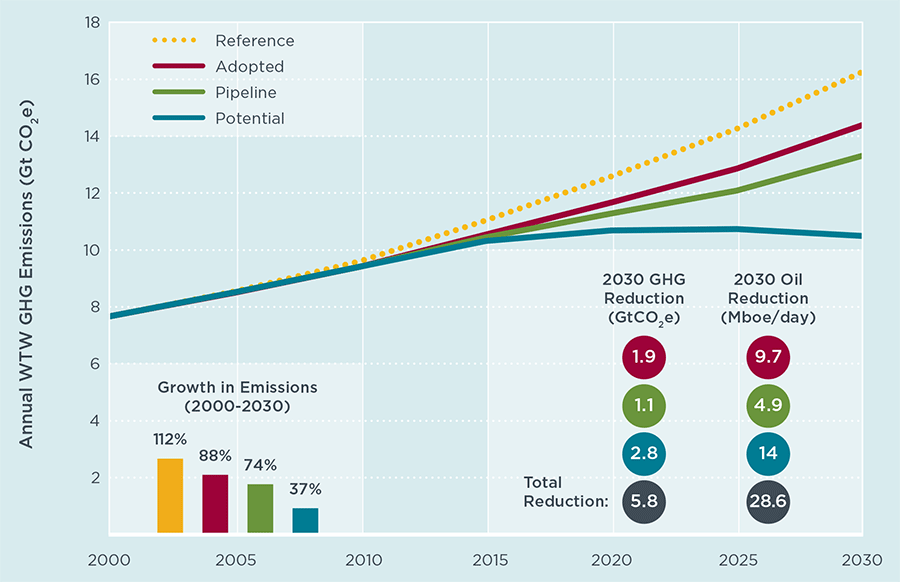The impact of vehicle and fuel standards on premature mortality and emissions
Report
Global transportation energy and climate roadmap
This report evaluates the impact of transportation policies on worldwide oil consumption and greenhouse gas (GHG) emissions and the potential for reductions in both out to 2030. It finds that policies adopted and formally announced since 2000 will have dramatic effects: reductions of 14 percent in global oil consumption and 7 percent in global economy-wide GHG emissions below the 2030 levels projected in the International Energy Agency (IEA)’s World Energy Outlook. The report concludes that spreading the world’s most advanced regulatory standards and cost-effective technologies to other major markets while supporting shifts to low-carbon modes could more than double these impressive reductions, essentially stabilizing global transportation emissions by 2020.
But despite the magnitude of emission reductions that can be realized by disseminating best-practice standards and technologies more widely, these alone will not put the transportation sector on a path to achieve the 50 to 85 percent reduction by 2050 (from 2000 levels) necessary to constrain global temperature increase to two degrees Celsius. That would require the adoption of a wider range of policies, along with a transformation of vehicle technologies and transportation systems, to increase the annual rate of emission reductions in the 2030 to 2050 time frame and meet the 50–85 percent target.
The Global transportation energy and climate roadmap seeks to provide government regulators, policymakers, and other stakeholders with answers to a range of critical policy questions. The analysis is based on the ICCT Global Transportation Roadmap model, an analytical tool that draws upon the best available data for global and national transportation emissions and policies. The Roadmap model focuses on the top vehicle markets, which are the largest GHG emitters and oil consumers within the transportation sector. These also tend to develop and adopt emission control and energy efficiency regulations first. Their experience establishes a suite of best-practice policies to draw upon.
Highlights
Policies adopted since 2000 in major vehicle markets will reduce global oil-equivalent consumption by 9.7 million barrels per day (Mboe/day) and GHG emissions by 1.9 metric gigatons of CO2 equivalent (GtCO2e) in 2030. These reductions will be equivalent to 9 percent of global oil consumption and 4 percent of global all-sector GHG emissions from 2030 levels in IEA’s World Energy Outlook.
 If adopted according to current expectations, policies in the pipeline will further increase these benefits. Together, adopted and pipeline policies represent reductions of 14.5 Mboe/day and 2.9 GtCO2e in 2030, equivalent to a 14 percent reduction in global oil consumption and a 7 percent reduction in global economy-wide GHG emissions from 2030 levels in IEA’s World Energy Outlook. Policies to improve the efficiency of on-road vehicles, marine vessels, and aircraft will accomplish the lion’s share of reductions.
If adopted according to current expectations, policies in the pipeline will further increase these benefits. Together, adopted and pipeline policies represent reductions of 14.5 Mboe/day and 2.9 GtCO2e in 2030, equivalent to a 14 percent reduction in global oil consumption and a 7 percent reduction in global economy-wide GHG emissions from 2030 levels in IEA’s World Energy Outlook. Policies to improve the efficiency of on-road vehicles, marine vessels, and aircraft will accomplish the lion’s share of reductions.
The full benefits of concerted regulatory action and rapid penetration of cost-effective technologies are illustrated by light-duty vehicle (LDV) policies. Despite a doubling of projected vehicle stock from 2000 to 2030, from 640 million to 1.5 billion, oil consumption and GHG emissions from LDVs are projected to stabilize in 2025, thanks to the adoption of strong fuel-efficiency and GHG emission standards in major markets since 2005.
Expansion of world-class policies and cost-effective technologies across the globe—including vehicle efficiency, mode shift, and activity reduction policies—would result in oil and emission reductions of 28.6 Mboe/day and 5.8 GtCO2e in 2030, equivalent to a 28 percent drop in global oil consumption and a 13 percent cut in global economy-wide GHG emissions from 2030 levels in IEA’s World Energy Outlook. This level of reduction would essentially stabilize transportation emissions by the year 2020.
